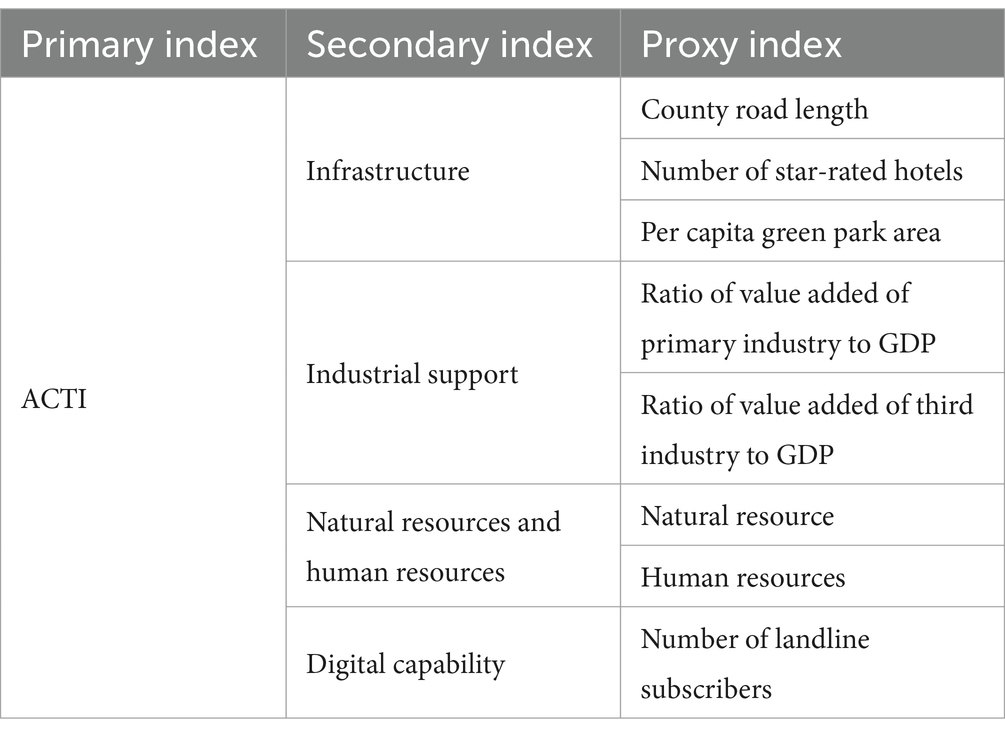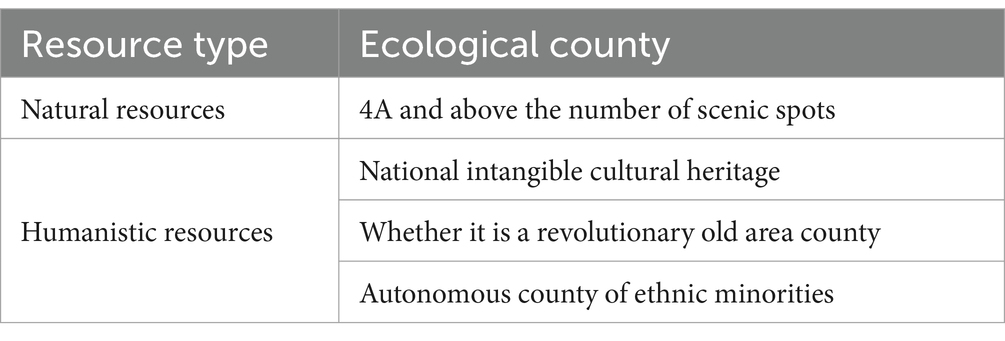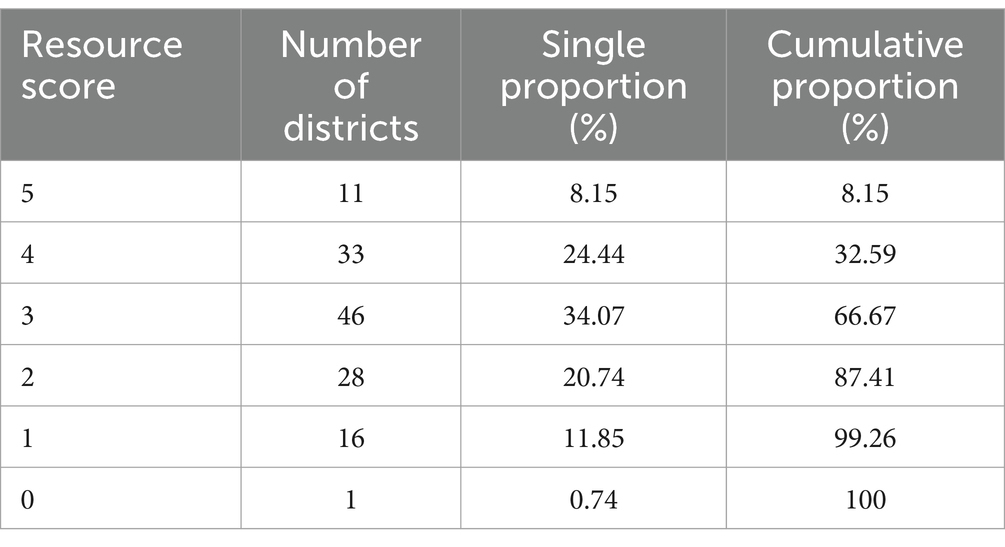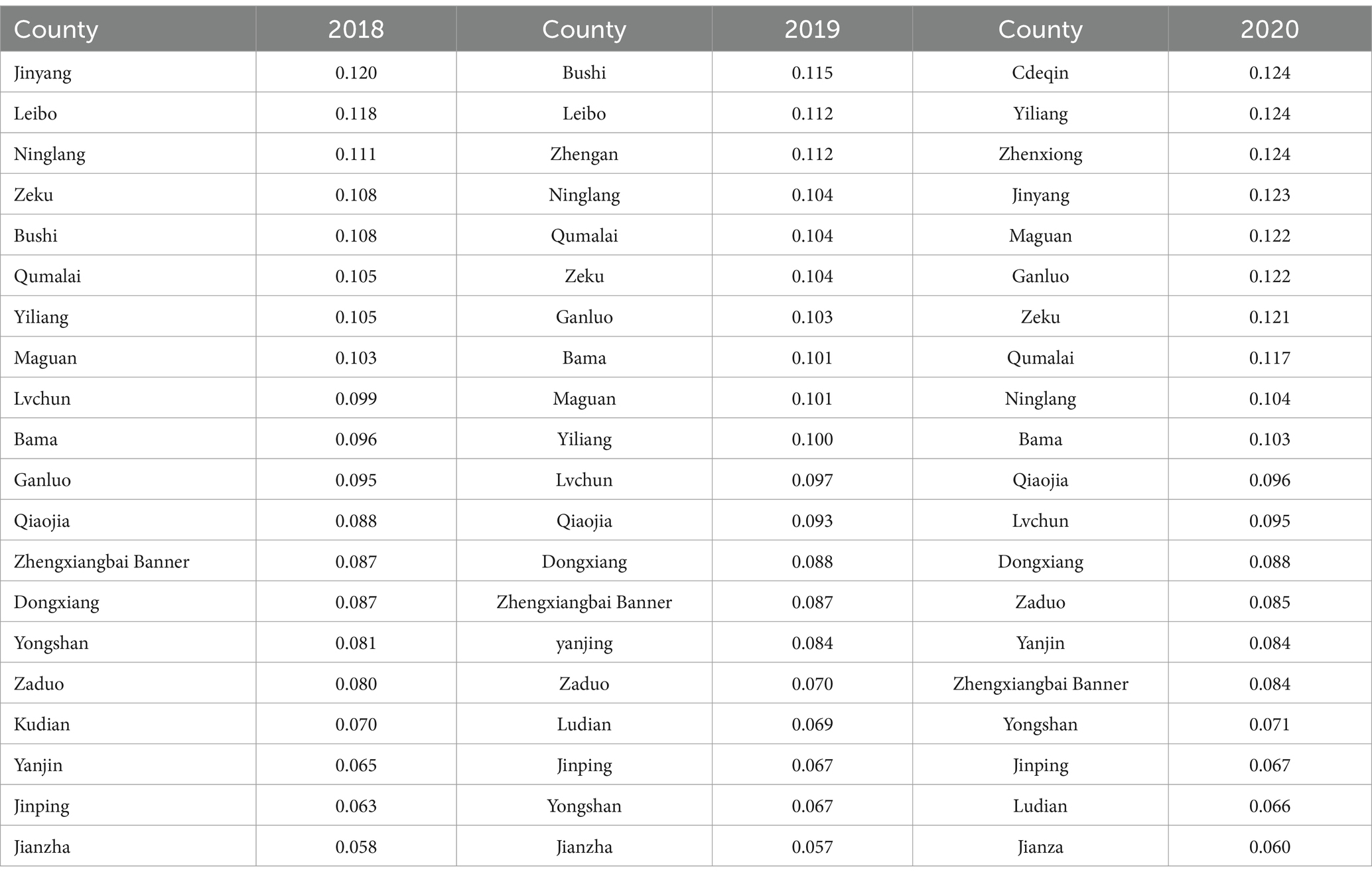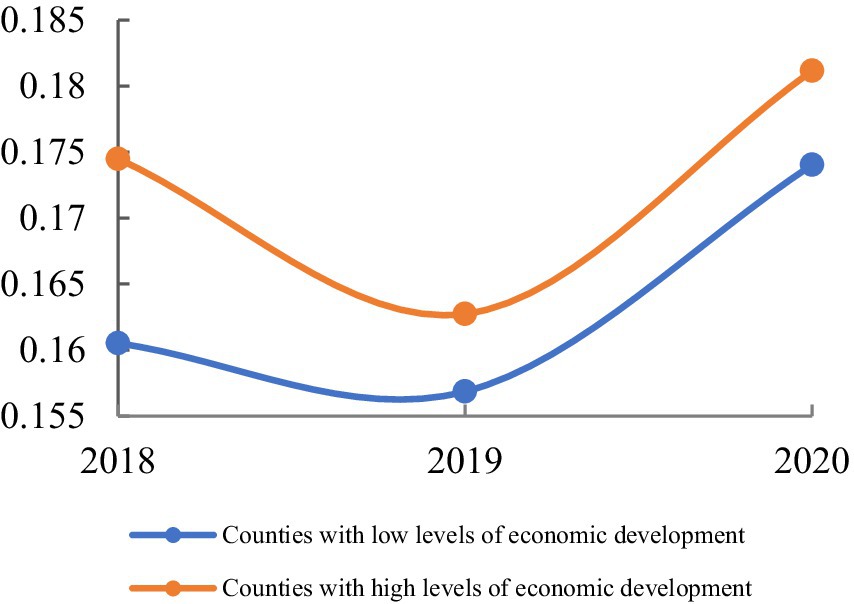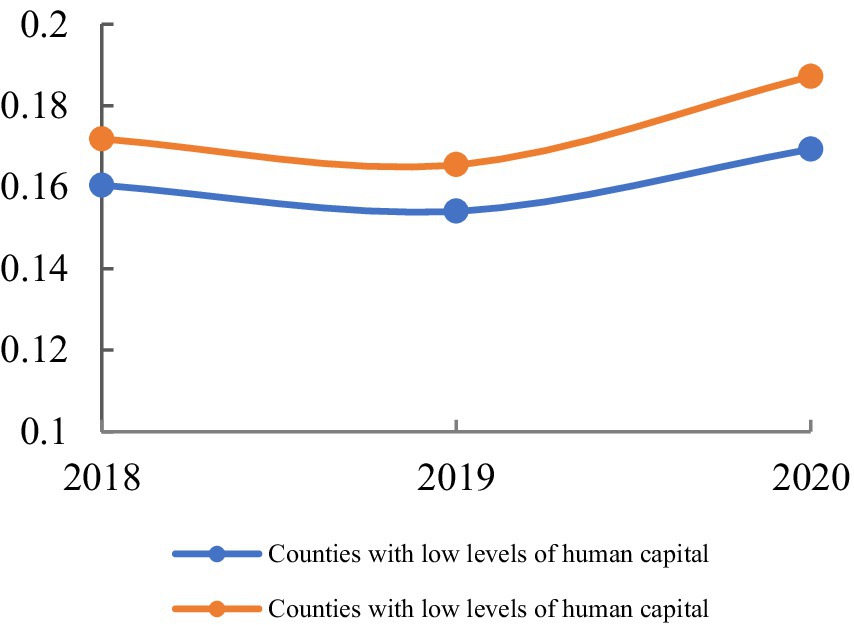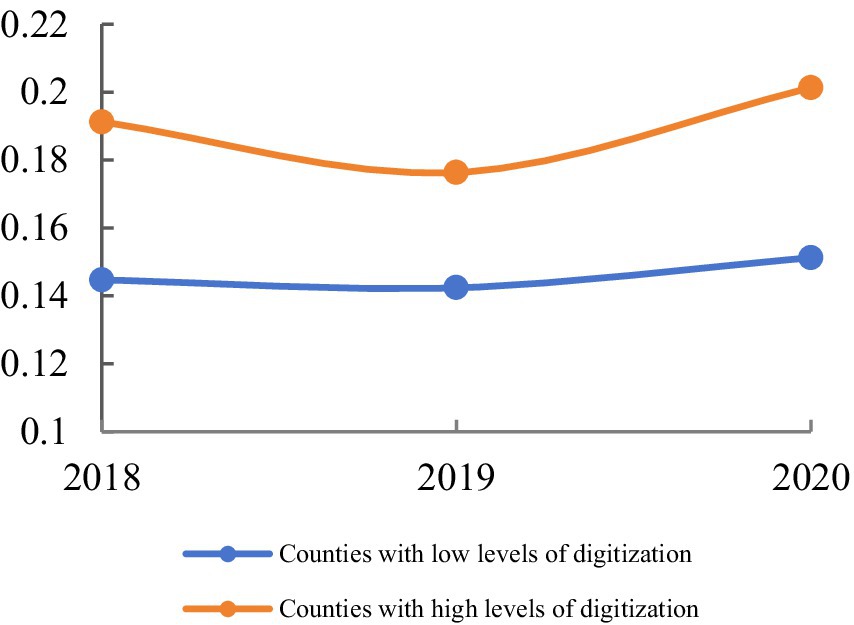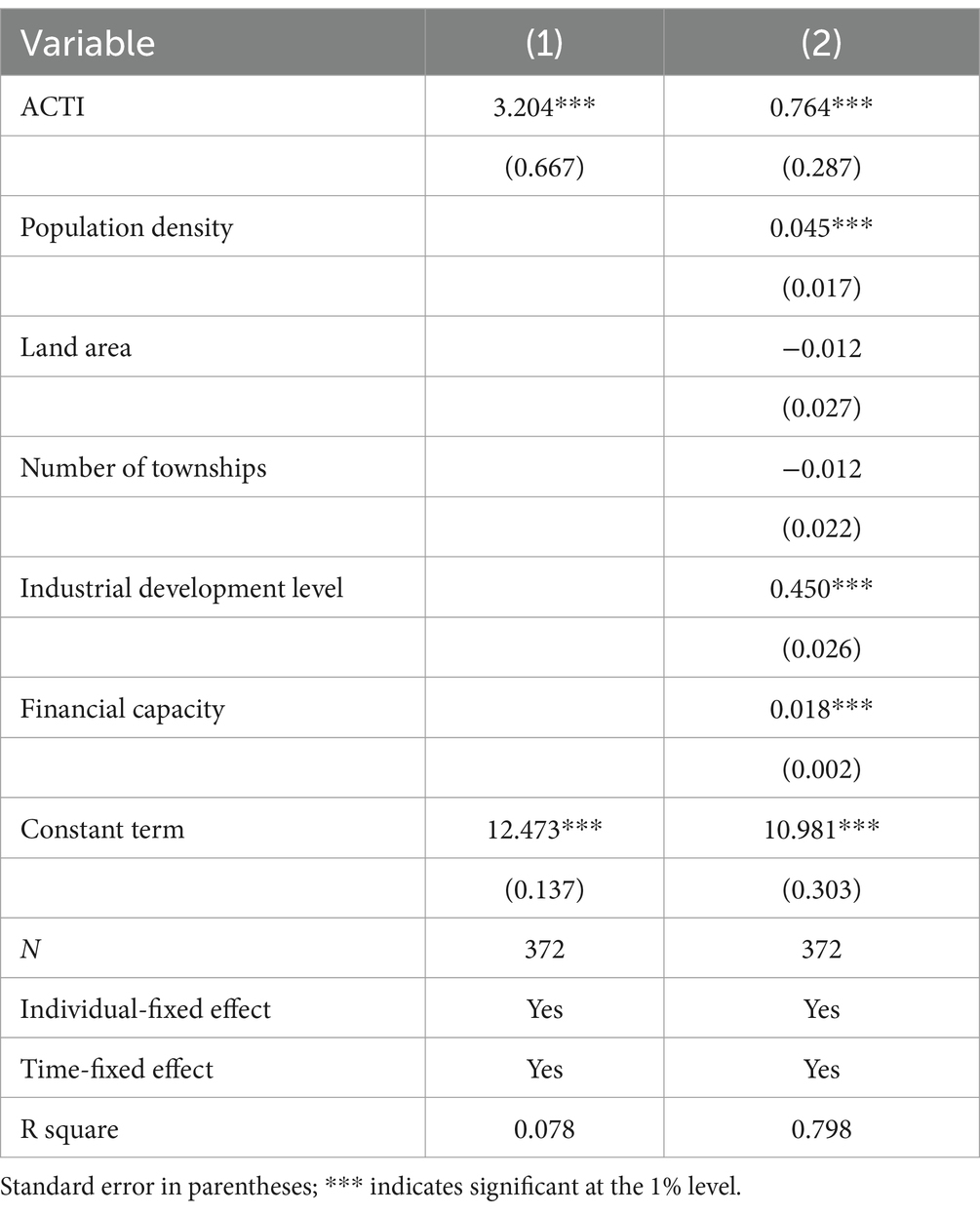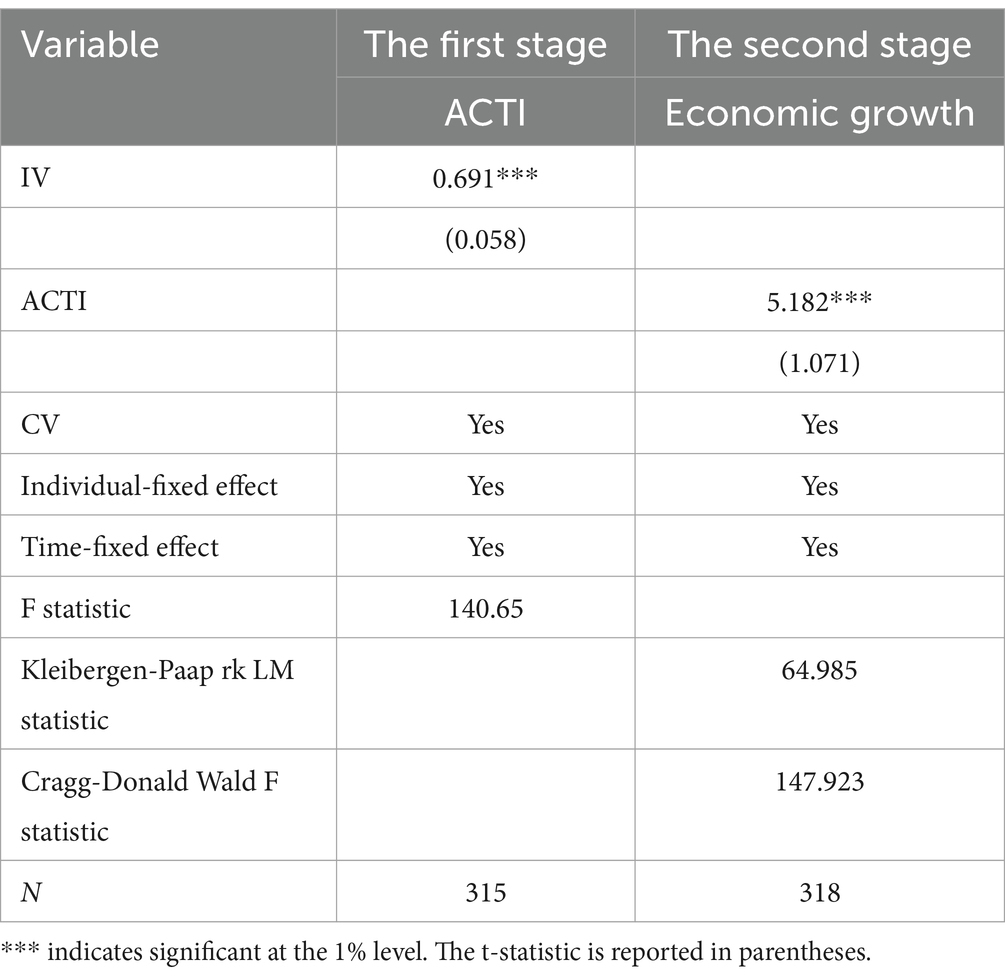- 1National Security College, Southwest University of Political Science and Law, Chongqing, China
- 2Public Administration College, Southwest University of Political Science and Law, Chongqing, China
The integration of agriculture, culture, and tourism industries as a driver of industrial modernization has become an essential strategy during China’s transition from rapid growth to high-quality development. In pursuit of the goal of common prosperity, local governments at various levels have actively responded by attempting to promote economic growth through the integration of these three industries. Data of 126 key national rural revitalization counties in China between 2018 and 2020 is selected as the sample, and an entropy value analysis is used, this paper discusses the integration level of agriculture, culture, and tourism industries in these counties and whether such integration has promoted local economic growth. The results show that while the integration level of these industries in key rural revitalization counties has seen fluctuating growth, the overall level remains low with significant disparities across regions. Counties with higher economic development, higher human capital, and higher digitalization levels tend to have higher integration levels of agriculture, culture, and tourism industries. However, compared to ethnic counties, non-ethnic counties, despite their disadvantage in ethnic culture, have achieved rapid growth and caught up in the integration of these industries by adapting to local conditions and leveraging local features. Further analysis indicates that even though the current integration level in these counties is not high, it still promotes local economic growth. The conclusions provide insights for counties transitioning from poverty alleviation to rural revitalization. By promoting the integrated development of agriculture, culture, and tourism industries, these counties can achieve economic growth, narrow regional development gaps, and ultimately realize the goal of common prosperity.
1 Introduction
Industrial integration is a necessary condition for industrial transformation and upgrading, as well as a key driver of economic growth. The 14th Five-Year Plan emphasizes the importance of integrating primary, secondary, and tertiary industries in rural areas, extending agricultural value chains, and diversifying rural economic activities to promote high-quality development at the county level. Against the backdrop of rural revitalization, the integration of agriculture, culture, and tourism (agri-cultural-tourism integration, ACTI) has emerged as a new engine for the development of rural areas and county-level economies (Gascón and Cañada, 2025). Rural tourism is regarded as an important measure to promote the sustainable growth of the rural economy in China, and it is also a necessary method to promote rural revitalization and the increase of farmers’ income (Cheng et al., 2025).
From an economic perspective, ACTI helps integrate local agricultural-cultural-tourism resources, optimizes industrial structures, and enhances local residents’ income levels (Wang et al., 2024; Abdurakhmanova and Ahrorov, 2025). Promoting ACTI in rural areas can also leverage the unique rural culture and agricultural heritage, fostering rural cultural revival and development, thereby achieving rural cultural prosperity (Gao and Wu, 2017). In recent years, several “Internet-famous villages” have emerged in China, such as Tianshui in Gansu and Rongjiang in Guizhou. These regions have improved their ACTI levels through local government efforts, the introduction of internet platform traffic, and multi-stakeholder participatory models, becoming new channels for rural revitalization. From an international comparative perspective, China’s ACTI exhibits distinct “government-led” characteristics. Unlike the market-driven models in Western countries, China has adopted a “policy package + project-based” mode, where the central government establishes special funds for ACTI under the rural revitalization strategy. These funds are allocated to lower-level governments through project-based mechanisms. This institutional arrangement effectively addresses market failures, particularly in impoverished areas, leading to the emergence of exemplary cases of industrial development. However, these observations are limited to the surface level of ACTI. The actual integration levels in these regions remain unclear, and questions arise as to whether government-led integration compromises market efficiency, potentially hindering economic growth in these counties.
Existing studies in economics and management have evaluated the economic effects generated by ACTI using data at different levels, but the research on farmers’ income is still very limited (Yang et al., 2025; Ahmed, 2025). Due to data accessibility constraints, county-level studies have primarily relied on survey data and focused on specific provinces. Since the implementation of China’s targeted poverty alleviation policy in 2013, numerous ACTI policies and projects have been implemented at the county level. Following the removal of poverty county designations in 2020, the sustainability of development and the prevention of re-poverty in these key counties for rural revitalization remain critical issues. ACTI can provide new growth opportunities for these counties, fostering economic growth in rural revitalization key counties. This study aims to address these gaps by using county-level data from 2018 to 2020 to measure and analyze the ACTI levels in key counties for rural revitalization and assess their effect on county-level economic growth. The contributions of this study are twofold: (1) we extend the evaluation of ACTI levels from the provincial to the county level, focusing on China’s national key counties for rural revitalization. This method provides more detailed and localized data, aligning with China’s current agri-cultural-tourism development practices; (2) we evaluate the effect of ACTI on economic growth, addressing whether government-led integration models are efficient.
2 Literature review
The phenomenon of industrial integration can be traced back to the restructuring of industry boundaries driven by information technology (Greenstein and Khanna, 1997). Published literature identified the dual drivers of industrial integration: technological innovation reduces integration costs, while policy deregulation provides institutional space for cross-industry collaboration (Hu, 2024). Although scholars have yet to reach a consensus on the definition of industrial integration, the classic definition by Greenstein and Khanna (1997) reveals its core characteristics: driven by technological advancements, industrial integration transforms production relationships, dissolves traditional boundaries between industries, and forms industrial ecosystems. From the perspective of industrial integration stages, the process typically involves four phases—technology, product, business, and market integration—before achieving comprehensive integration. Technological integration, driven by technological updates and introductions, leads to the blurring of industry boundaries and is the first step in the integration process. Product and business integration involve the combination of highly correlated products and business resources across industries, representing a deepening phase of industrial integration. Market integration refers to the integration of market operations and marketing strategies at the market level. Cultural capital theory provides a new perspective for cultural-tourism integration, as the fusion of cultural resources creates competitive cultural-tourism products through creativity and innovation (Alberti and Giusti, 2012). In the agricultural domain, integration research has shifted from a single economic perspective to a systemic ecological paradigm. Early scholars focused on the economic benefits of agritourism (Fleischer and Tchetchik, 2005; Wei et al., 2024), but the simplistic “agriculture + tourism” model has limitations in terms of sustainable value creation. Gao and Wu (2017), based on innovation ecosystem theory, argued that ACTI is evolving into an innovation ecosystem. This method emphasizes the organic coupling of value chains across agriculture, culture, and tourism, forming an ecosystem that includes element flows and value co-creation.
In recent years, with the deepening application of digital technologies, the development of ACTI has increasingly focused on enhancing consumer experience value through digital technologies or platforms (Xiang, 2018; Li and Wang, 2025). This mode of development promotes ACTI in underdeveloped areas by engaging multiple stakeholders in the ecosystem (Wu et al., 2022; Wang and Wang, 2023). However, despite rapid development, ACTI faces several challenges. For instance, over-symbolization or blind development has led to resource homogenization, environmental pollution, and wasted resources (Yan, 2019). Additionally, issues such as inadequate infrastructure, irregular operations, chaotic market order, and disorganized online information (Liu, 2021), as well as low-quality industrial branding and insufficient digitalization capabilities, hinder sustainable development and user experience value, ultimately affecting economic growth (Cuomo et al., 2021; Lin and Li, 2024).
From an economic perspective, existing studies suggest that ACTI has a positive impact on economic growth. Such integration extends industrial chains, creates non-agricultural employment opportunities, increases income elasticity, and raises residents’ income levels (Wang et al., 2024). The integration process often promotes the development of new agricultural business entities, such as agricultural cooperatives (Bachleitner and Zins, 1999), driving changes in industrial organization and improving development efficiency. Beyond its economic effects, ACTI also enhances farmers’ sense of identity and fosters rural cultural IP, thereby promoting rural cultural development (Hughes and Allen, 2005). However, most of these studies rely on case analyses or theoretical frameworks, while empirical research has primarily focused on provincial or urban levels, with fewer studies conducted at the county level. Some studies also show that there are a large number of conflicts between tourism and agriculture, and the integrated development of the two is not conducive to increasing farmers’ income (Wanner et al., 2021; Pillay and Rogerson, 2013; Zhu et al., 2025). Therefore, whether ACTI can promote economic growth in poverty-stricken areas remains an open topic. The potential contributions of this study are as follows: (1) By using the data of key counties for poverty alleviation assistance and the entropy weight method to calculate their ACTI index, the basic current situation of agricultural, cultural and tourism resource development in backward areas of China was clarified. (2) Combined with the county-level database, the article demonstrates the positive role of ACTI in economic growth.
3 Research design and data sources
3.1 Research methods
In the measurement of comprehensive indicators, unlike subjective empowerment methods such as the analytic hierarchy process, the entropy method determines weights based on the information provided by the original indicators. Therefore, the entropy method is widely used due to its objectivity in determining indicator weights. Given the requirements of this study, the entropy method was used to determine the weights of the indicators for the ACTI and to calculate the integration level. Let there be n evaluation indicators, where n = 9; and t evaluation years, with the sample years being 2018 to 2020, so t = 3. Xij represents the value of the j-th indicator in the i-th year. Its calculation processes are respectively: (1) Data standardization processing; (2) Solving the weights of each index; (3) calculating the comprehensive score.
3.1.1 Data standardization
The ACTI involves three types of industries, with a complex connotation and a wide range of indicators. The units and information of the original indicators also differ, so it is necessary to standardize the indicators to maintain consistent dimensions. For positive indicators, the positive indicator calculation method is used; for negative indicators, the negative indicator calculation method is used. The calculation method for positive indicators is:
In Equation 1, i and j are economic variables. Since all the indicators selected in this paper are positive, the step of standardizing negative indicators can be omitted if there are no negative indicators. Calculate the proportion of the j-th indicator in the i-th year. Its calculation process is shown as Equation 2.
By calculating the information entropy of the index, the following equation can be obtained:
In Equation 3, e is information entropy, t is time, . Using the information entropy of the data to calculate the redundancy, the following equation can be obtained:
In Equation 4, d is information redundancy. The weight calculation equation of each index is as follows:
In Equation 5, w is the weight information. According to index weights and annotated values, the comprehensive sub-calculation equation for a single index is as follows:
In Equation 6, is the composite score of a single index. This process is repeated and the results of ACTI are obtained by summing up all indicators.
In Equation 7, is the evaluation result of ACTI.
3.2 Data sources
This study is based on the “China County Statistical Yearbook,” “China County (City) Socioeconomic Statistical Yearbook,” the EPS data, and datasets from China Economic Net. Data from 2018 to 2020 were collected. The overall county-level range was selected based on the list of 160 key poverty alleviation counties. Data on national intangible cultural heritage and national 4A and above tourist attractions were manually compiled from the official website of the Chinese Intangible Cultural Heritage Office and the official websites of provincial cultural and tourism departments. This paper matched data at the county level and performed unit conversion and missing value removal on the initial data, resulting in 372 sample observations of balanced panel data.
3.3 ACTI index evaluation system
Domestic scholars have primarily constructed indicator systems for measuring the integration of agriculture and tourism or culture and tourism by combining agriculture and tourism or culture and tourism. Therefore, this paper draws on the indicator system forms of agricultural-tourism integration and cultural-tourism integration, considering principles such as comprehensiveness, hierarchy, scientific objectivity, and availability of indicators. An evaluation indicator system for the integration of Agricultural-Cultural-Tourism industries was constructed as shown in Table 1.
This study selects a total of four first-level indicators and eight second-level indicators to measure ACTI. The four first-level indicators include infrastructure, natural and cultural resource conditions, and digital support. The second-level indicators for ACTI infrastructure include county town highway length, number of starred hotels, and per capita park green area. Industrial support for ACTI focuses on the first and tertiary industries, selecting the share of first industry value added in GDP and the share of tertiary industry value added in GDP as second-level indicators. Due to the absence of variables, such as cultural industry value added in key rural revitalization counties, cultural industry-related variables, are not included in the indicator system. The second-level indicators for natural and cultural resource conditions are classified based on natural and human resources. Specifically, ecological counties and 4A and above scenic spots are categorized as natural resources, while revolutionary old counties, ethnic counties, and national intangible cultural heritage projects are classified as human resources. Ecological counties, revolutionary old counties, and ethnic counties are binary variables, each representing one point. The remaining two types of resources, 4A and above scenic spots and national intangible cultural heritage, are scored based on their levels and quantities. For example, having a 4A-level scenic spot earns 1 point, and a 5A-level scenic spot earns 2 points. National intangible cultural heritage is scored based on quantity: 1–3 items earn 1 point, 4–6 items earn 2 points, and 7–9 items earn 3 points. The final scores for natural and human resources are determined, and their distribution characteristics in key rural revitalization counties can be seen in Tables 2, 3.
From Tables 2, 3, it can be observed that counties with a score of 5 account for 8.15%, and counties with scores of 3 and 4 are the most common. Counties with a score of 3 account for 66.67%, exceeding 50%, while counties with a score of 1 account for 99.26%, meaning over 90% of rural revitalization key counties possess at least one resource. Digital support for ACTI primarily includes the county’s rural digital economy index and broadband access user count. Fixed telephone user numbers are sourced from EPS data. Since all indicators are positive variables, they undergo positive variable standardization.
4 Analysis of measurement results
4.1 ACTI results in key assisted counties
Based on the entropy weight method and the evaluation index system constructed in Table 1, this study calculated and obtained the ACTI index of the key assistance counties.
It can be seen from Table 4. the ACTI in key rural revitalization counties from 2018 to 2022 were calculated as 0.166, 0.160, and 0.178 (on a scale of 0 to 1). This indicates that the integration level of ACTI in these counties remains relatively low. Despite a series of supportive policies enacted by national and local governments to promote the integration of industries in key rural revitalization counties, such as upgrading infrastructure, fostering specialty industries, strengthening agricultural production and marketing, tourism assistance, and enhancing public cultural construction, however, the integration level remains low. From a geographical and natural environment perspective, these counties are often located in remote, high-altitude, or border areas of western China, characterized by harsh natural conditions. Their economic and industrial development is relatively underdeveloped. From an infrastructure and public services perspective, the economic development of these counties is hindered by their remote locations and challenging natural conditions, resulting in lower levels of infrastructure and public services. From a digital perspective, these counties lack robust digital infrastructure, creating a digital divide compared to counties in eastern regions, which limits the effectiveness of digital empowerment in promoting ACTI. Additionally, the delayed implementation effects of policies contribute to the persistently low integration levels.
4.2 County-level disparities in integration levels
From a county-level perspective, Table 4 presents the top 20 counties with the highest ACTI levels from 2018 to 2020, while Table 4 reports the bottom 20 counties. Table 4 reveals that Gonghe County ranked first with integration levels of 0.561, 0.573, and 0.620, showing a steady increase. Conversely, Table 5 shows that Jianzha County ranked last with levels of 0.058, 0.057, and 0.060. Further analysis indicates that the scores of the top-ranked counties were approximately ten times higher than those of the bottom-ranked counties during the observation period. This significant disparity highlights the overall low integration levels and substantial county-level differences.
The reasons for these disparities lie in the distinct geographical, natural, economic, and policy conditions across counties. Counties closer to central cities may enjoy advantages in infrastructure, market resources, and policy support, while those in remote, mountainous, or high-altitude areas face more developmental challenges. From an industrial development perspective, some counties have established mature agricultural, cultural, and tourism industries with effective integration mechanisms, while others remain in the early stages of integration, lacking effective industrial linkages and coordination. Additionally, some counties designated as ecological function counties face restricted industrial development. From a policy perspective, while supportive policies have been enacted, their implementation and effectiveness vary significantly across counties, contributing to the observed disparities.
4.3 County-level characteristics in ACTI
As noted earlier, significant county-level disparities exist in ACTI. This section further classifies these disparities based on specific county characteristics.
4.3.1 Classification based on economic development level
Existing literature suggests that economic development is a key factor influencing industrial integration (Kozak et al., 2019). Figure 1 illustrates the differences in ACTI levels across counties classified by their economic development levels, represented by per capita GDP. Both high-and low-economic-development counties exhibit relatively low integration levels, though higher economic development correlates with slightly higher integration levels. This discrepancy arises because counties with higher economic development often have stronger industrial foundations, enabling better coordination among agriculture, culture, and tourism. In contrast, economically underdeveloped counties face challenges such as weak agricultural industrialization, inadequate cultural resources, and limited tourism appeal, which collectively hinder integration. Additionally, counties with higher economic development typically possess greater human capital and innovation capabilities, attracting skilled labor and fostering innovative integration models, such as digital empowerment and new tourism products. Conversely, economically underdeveloped counties often lack the necessary human capital and technological support to drive integration.
4.3.2 Classification based on human capital
The outflow of agricultural labor to non-agricultural sectors, driven by economic development and industrialization, has led to a critical shortage of human capital in rural areas (Huang et al., 2002). Human capital also plays a role in integration levels, as highlighted by the lack of skilled professionals and managers capable of fostering integration. To explore the impact of human capital on ACTI, this study uses the number of students in ordinary schools as a proxy variable, dividing counties into two groups based on median values. Figure 2 reveals that counties with higher human capital exhibit higher integration levels compared to those with lower human capital.
4.3.3 Classification analysis of ACTI in key counties by ethnic county status
Under the context of rural revitalization, cultural revitalization has become a critical component of rural development. Many counties and townships have begun to emphasize the exploration of cultural resources, industrializing these resources and integrating them with agriculture and tourism to form a development model of Agricultural-Cultural-Tourism fusion. Among these efforts, the exploration of local ethnic and folk cultures has been a focal point. For instance, Yongjiang County in Guizhou Province is one of the national key poverty-stricken counties and also an ethnic county, boasting rich ethnic cultural resources. In recent years, Yongjiang County has leveraged its traditional strengths in rural football by innovatively hosting events such as the Yongjiang (Three Treasures Dong Village) and the Beautiful Countryside Village Football Super League (abbreviated as “Village Super League”), promoting the integration of football with specialty agriculture, ethnic culture, and rural tourism. This effort explores a model of how cultural and tourism integration can empower rural revitalization. Based on this, this section categorizes counties by whether they are ethnic counties and discusses the impact of ethnic cultural endowments on the ACTI in key rural revitalization counties.
From Figure 3, it is evident that, on average, ethnic counties exhibit higher Agricultural-Cultural-Tourism integration levels compared to non-ethnic counties. This is attributed to the unique ethnic cultures serving as a critical resource foundation and innovation driver for Agricultural-Cultural-Tourism integration. However, starting from 2020, non-ethnic counties have shown an upward trend in their integration levels, surpassing those of ethnic counties. This may be due to two factors: (1) Ethnic counties’ Agricultural-Cultural-Tourism integration models urgently need innovation. In previous efforts, some counties, despite possessing unique ethnic cultural resources, lacked a deep understanding of these cultural contents. As a result, the development of ethnic cultural resources was limited to simple combinations of culture with agriculture and tourism, leading to high homogeneity in integration models. These models struggle to adapt to market developments and tourist demands, resulting in declining sustainability in value creation. (2) Non-ethnic counties, even with insufficient ethnic cultural endowments, have innovated their Agricultural-Cultural-Tourism integration models by adapting to local characteristics. This has also elevated their integration levels.
4.3.4 Classification analysis of ACTI in key dounties by digitalization level
In the context of digital knowledge and information rapidly permeating various production processes, the impact of digital technology on industrial integration has garnered significant attention. Digital knowledge and information, facilitated by modern information technology, can drive infrastructure construction, strengthen data and technological support for industrial integration, promote the rational allocation of labor resources, and improve industrial organizational systems. Consequently, industries are pushed toward networked, digitized, and intelligent development, fostering the fusion and cross-reorganization of primary, secondary, and tertiary industries. To examine the impact of digitalization levels on Agricultural-Cultural-Tourism integration levels, this study categorizes counties based on their rural digital village indexes. These indexes are compiled from the County Digital Village Index (2018–2020) released by Peking University. The results are presented in Figure 4.
From Figure 4, it is evident that counties with lower digitalization levels exhibit significantly lower Agricultural-Cultural-Tourism integration levels compared to counties with higher digitalization levels. Moreover, this disparity shows an increasing trend. This can be attributed to the long-term and progressive characteristics of the cross-industry integration of agriculture, culture, and tourism driven by digital technologies. These traits stem from the strong natural attributes of agricultural industries, the single nature of small-scale farming operations, scattered data resources, high data integration costs, and the widening rural–urban digital divide. In the context of uneven industrial development and significant regional and rural–urban disparities in key rural revitalization counties, the low penetration rate of digital technologies in agriculture and their uneven distribution further limit the potential for value creation in Agricultural-Cultural-Tourism integration. This has become a bottleneck hindering the comprehensive revitalization of rural areas in key counties under the digital economy.
5 The impact of ACTI on rural economy
5.1 Empirical model
In the previous sections, this study used the entropy weight method to evaluate the integration level of agricultural-cultural-tourism industries in key poverty alleviation counties during the rural revitalization initiative. The question arises: Does ACTI promote county-level economic growth and thereby help key poverty alleviation counties achieve prosperity and escape poverty? To assess the impact of agricultural-cultural-tourism integration on economic growth, the following fixed effects model is constructed:
In Equation 8, represents the economic growth level of county i in year t, measured by GDP and taken in natural logarithm form for regression. ACTI is the integration level of agricultural-cultural-tourism industries, calculated based on the entropy weight method and the indicator system presented in Table 1. are the control variables, which include county population density, land area, the number of towns and townships, the level of industrial development, and local fiscal capacity. Population density is measured as the number of people per square kilometer. Industrial development is assessed by the number of industrial enterprises above a designated size, and local fiscal capacity is measured by local government budget expenditures. is the error term.
5.2 Baseline regression analysis
Table 6 reports the baseline regression results estimated using Equation 8. Column (1) presents the results without any control variables, while column (2) includes county population density, land area, the number of towns and townships, industrial development level, and local fiscal capacity as control variables.
From Table 6, it is evident that regardless of whether control variables are included, the improvement in ACTI has a significantly positive impact on the economic growth of key poverty alleviation counties. It is obvious that ACTI has achieved mutual penetration among the three industries, leading to an increase in the value of the main business products of farmers and agricultural enterprises (Zhou et al., 2022). If agricultural and sideline products are sold as specialties after being finely processed and packaged, the added value of agricultural products will be enhanced. As a result, the prices of agricultural products will rise, which leads to mutual penetration among industries. The traditional single agricultural product industrial chain extends to the rural tourism industrial chain, promoting the value-added of agriculture and tourism. The development of tourism has given rise to the demand of tourists for the catering and accommodation industries. The relevant entities have combined the related industries into a more complex industrial chain, which can promote the local economic development. The integration of agriculture and tourism combines various resources, including natural resources, ecological resources, cultural resources, etc., to achieve comprehensive development and utilization and enhance the level of industrial development. The integration of agriculture and tourism has expanded new economic development models and formed new business forms through the extension of the industrial chain. The development of tourism has provided new channels for the sales of agricultural products, forming an integrated development model, which is conducive to the high-quality development of agriculture. The theory of new economic geography points out that the agglomeration of the tourism industry is that the tourism industry generates a cumulative effect through forward and backward correlations, and has a large and lasting impact under the action of the cumulative cyclical causal relationship (Wang et al., 2023). The integration of agriculture and tourism promotes the extension of the tourism industry chain, drives the aggregation of the tourism industry, and brings in production factors such as capital, technology and labor force to the region. The output of products and services brings income to the regional tourism economy, thereby promoting the growth and expansion of the tourism economy (Chen and Cai, 2025; Dai et al., 2023).
Analyzing the control variables, population density is found to have a significant positive effect on economic growth. This is attributed to two factors: On the one hand, higher population density increases the cost-effectiveness of infrastructure construction in key poverty alleviation counties. With a larger population, the fixed costs of infrastructure can be distributed among more people, reducing the unit cost of investments. This improvement in infrastructure enhances the investment environment, attracting more enterprises and agricultural-cultural-tourism integration projects, thereby driving economic growth. On the other hand, greater population density facilitates the rapid dissemination of knowledge and information. The swift spread of new technologies, concepts, management practices, and entrepreneurial experiences fosters human capital development and entrepreneurial vitality, particularly in innovative sectors such as specialized agriculture, creative agriculture, and rural e-commerce live streaming, injecting new momentum into rural economic growth. Additionally, industrial development levels and local fiscal capacity are found to positively influence economic growth, consistent with traditional economic growth theories.
5.3 Robustness test
5.3.1 Replacing the dependent variable with per capita GDP
To reduce the interference of population size differences across counties, this study replaces GDP with per capita GDP. The results are reported in Column (1) of Table 7. From column (1), it is evident that even after replacing GDP with per capita GDP, the ACTI continues to promote economic growth in key poverty alleviation counties.
5.3.2 Excluding counties rich in tourism resources
The ACTI is closely related to a county’s tourism resources. Counties with abundant tourism resources generally have a stronger foundation for integration. To address this, the study re-regresses the model after excluding counties with 4A-level scenic spots. The results are presented in column (2) of Table 7. Even after excluding counties with 4A scenic spots, the ACTI remains positively correlated with economic growth at the 5% significance level, indicating the robustness of the study’s conclusions.
5.3.3 Considering the impact of other policies on county-level economic growth
Counties play a critical role in bridging urban–rural divides and reducing regional disparities to promote economic growth. Geographical location, resource endowments, and urban–rural “dual structures” are among the factors perpetuating regional and urban–rural disparities. Narrowing county-level development gaps is an effective pathway to economic growth. Since 2016, when the leader of the Chinese government convened a symposium in Yinchuan, inter-provincial collaboration has been significantly improved in terms of work mechanisms, fields of cooperation, and collaborative tasks, effectively promoting precision poverty alleviation in western regions. Following the eradication of absolute poverty in 2020, the objectives of inter-provincial collaboration have shifted toward promoting rural revitalization and reducing regional development disparities. The effectiveness of inter-provincial collaboration is evident in its significant positive impact on raising the actual GDP and per capita GDP levels of western counties (Zhang et al., 2023). It also promotes county-level economic growth through industrial transfer and the promotion of industrial integration. In 2017, the “Hand in Hand Poverty Alleviation Action” was launched to further mobilize resources from developed eastern regions to support industrial development and integration in western counties, thereby influencing economic growth. To further ensure the robustness of the results, this study introduces a dummy variable for counties participating in the “Hand in Hand Poverty Alleviation Action” into the regression model.
The results are reported in column (3) of Table 7. Even after accounting for the impact of inter-provincial collaboration, the ACTI remains a significant driver of economic growth in key poverty alleviation counties. This indicates that the results of the benchmark regression in this paper are robust.
5.4 Endogeneity test
The indicators selected for constructing the ACTI index, such as industrial development levels and infrastructure, are closely associated with economic growth. This inherent correlation makes it unavoidable to address potential endogeneity in the study, as there may be bidirectional causality between ACTI and county-level economic growth. To mitigate the influence of bidirectional causality, this study employs an instrumental variable (IV) approach to address endogeneity. Specifically, the average ACTI in other counties within the same city is used as the instrumental variable. The selection of this IV is based on two criteria: For relevance, sample counties within the same city share similarities in infrastructure, natural and human environments, and policy conditions. And for exogeneity, from the perspective of political tournaments, GDP is a key performance indicator for officials, and counties within the same city are in competitive relationships (Shen and Zhang, 2024). Therefore, the ACTI in one county will not directly influence the economic growth of other counties within the same city. The results of the two-stage least squares (2SLS) regression using the instrumental variable are presented in Table 8.
As can be seen from Table 8, the F-value of the first-stage IV regression is 140.65, meeting the relevance criteria. The Kleibergen-Paap rk LM statistic is 64.985, and the Cragg-Donald Wald F statistic is 147.923, indicating that the instrumental variable passes both the over-identification and weak instrument tests. Furthermore, in the second-stage regression, the coefficient of ACTI on economic growth remains significantly positive at the 1% statistical level and increases in magnitude, demonstrating that the IV effectively addresses the endogeneity issue in the study. Therefore, we can consider that the conclusion that ACTI will promote economic growth after eliminating endogeneity problems still holds. This conclusion is the result of causal inference.
6 Conclusion and policy recommendations
6.1 Conclusion
This study is based on the theoretical foundation of ACTI. Using data from 2018 to 2020 on China’s key poverty alleviation counties during the rural revitalization initiative, the research established an evaluation index system for agricultural-cultural-tourism integration development. The entropy weight method was employed to assess the integration level of agricultural-cultural-tourism industries in these counties and evaluate their impact on county-level economic growth. The key conclusions are as follows: Firstly, during the period of 2018–2020, the overall integration level of agricultural-cultural-tourism industries in China’s key poverty alleviation counties remained low but showed an upward trend. Secondly, significant inter-county disparities exist in the integration levels of agricultural-cultural-tourism industries among these counties. Thirdly, the integration level of agricultural-cultural-tourism industries is closely associated with county-specific characteristics. Counties with higher economic development, greater human capital, and advanced digitalization exhibit higher integration levels. However, compared to ethnic counties, non-ethnic counties are rapidly catching up in terms of integration levels. Lastly, despite the relatively low integration level of agricultural-cultural-tourism industries in these counties, they still contribute positively to county-level economic growth. This conclusion holds robust after a series of stability tests and the use of instrumental variables to address endogeneity. This study provides important insights for accelerating agricultural-cultural-tourism integration to promote economic growth in key poverty alleviation counties.
6.2 Policy implication
(1) Implement a differentiated agricultural-cultural-tourism Integration strategy to narrow county-level development gaps. To promote the development of key poverty alleviation counties, it is crucial to adopt a differentiated strategy for agricultural-cultural-tourism integration. Firstly, for counties with low integration levels, central fiscal transfers should be increased. These counties often face challenges such as weak infrastructure, inadequate transportation networks (which hinder tourist access and agricultural product distribution), underdeveloped digital infrastructure (limiting e-commerce growth), and insufficient public tourism facilities. Addressing these issues by improving infrastructure is essential for laying the foundation for future development. For high-potential counties, a “subsidy-to-incentive” mechanism should be implemented to encourage them to serve as demonstrators. These counties, with advantages in industrial foundations and resource endowments, can be incentivized through rewards to further exploit their potential, creating replicable and scalable experiences that drive neighboring counties’ development. Furthermore, A “strong county, weak county” pairing mechanism should be established. Strong counties, leveraging their advantages in resources, markets, and management, can share resources with weaker counties, jointly plan tourism routes, and integrate cultural and tourism resources along these routes. This collaboration can enhance regional competitiveness and gradually reduce economic disparities between counties.
(2) Strengthen factor guarantee mechanisms to overcome development bottlenecks. Intensify efforts in the “Digital Rural Strategy” to inject new momentum into county development. Establish agricultural-cultural-tourism big data centers to monitor resource dynamics in real time, implement flow warnings, and promote digitized marketing through platforms like live-streaming e-commerce and cloud tourism. Innovate talent cultivation models by launching “county-school cooperation” programs. Partner with vocational colleges to establish rural tourism academies, tailoring training to local demands to cultivate practical, industry-ready talent. Implement a “New Hometown Returning Entrepreneurs Program” by offering entrepreneurial subsidies and tax incentives to attract investors, technicians, and experienced professionals to return and start businesses, injecting fresh vitality into county-level agricultural-cultural-tourism integration.
(3) Tailor development paths for ethnic regions to deepen ethnic characteristic development. Ethnic regions possess unique cultural resources, and deepening their characteristic development is a key pathway to achieving rural revitalization. Establish a dedicated fund for the protection and development of ethnic cultural heritage, providing special subsidies to non-material cultural heritage inheritors to safeguard and transmit invaluable intangible cultural assets. Promote the “Non-Heritage Workshop + Scenic Spot + Research and Learning” model, integrating non-heritage into scenic areas and educational activities to realize economic value while preserving cultural heritage. Build an ethnic tourism brand matrix by developing ethnic festival IP and establishing a “one county, one festival” framework to enhance regional visibility.
(4) Innovate mechanisms and models to perfect the guarantee system for ACTI. Develop innovative financial instruments, such as agricultural-cultural-tourism project mortgage loans based on expected revenue, to provide funding channels for agricultural-cultural-tourism projects. Establish rural revitalization agricultural-cultural-tourism investment funds to attract private capital. Pilot carbon trade projects for agricultural-cultural-tourism to explore pathways for coordinated economic and ecological development. Explore mechanisms for realizing ecological product value, establish ecological resource asset accounts, and quantify ecological resource values. Improve eco-compensation mechanisms to incentivize ecological protection during tourism development, fostering a virtuous cycle between tourism development and environmental conservation to promote sustainable county-level development. Enhance benefit-sharing mechanisms by promoting innovative collaboration models among enterprises, governments, and farmers. Enterprises contribute capital, technology, and market access, while village collectives provide land and resources. Farmers participate in production and operations, ensuring they benefit across the entire value chain, thereby increasing their enthusiasm for rural revitalization and fostering stable economic and social development.
Data availability statement
Publicly available datasets were analyzed in this study. This data can be found here: the original contributions presented in the study are included in the article/supplementary material, further inquiries can be directed to the corresponding author.
Author contributions
LS: Conceptualization, Data curation, Formal analysis, Methodology, Validation, Writing – original draft. XL: Supervision, Project administration. Investigation, Resources, Writing – review & editing.
Funding
The author(s) declare that financial support was received for the research and/or publication of this article. This research was supported by the Chongqing Municipal Education Commission (24SKJD010), the funding is supported by the Sichuan Police College (JCZFQN202402), and the funding is supported by the Southwest University of Political Science and Law (2024XZXS-081).
Conflict of interest
The authors declare that the research was conducted in the absence of any commercial or financial relationships that could be construed as a potential conflict of interest.
Generative AI statement
The authors declare that no Gen AI was used in the creation of this manuscript.
Publisher’s note
All claims expressed in this article are solely those of the authors and do not necessarily represent those of their affiliated organizations, or those of the publisher, the editors and the reviewers. Any product that may be evaluated in this article, or claim that may be made by its manufacturer, is not guaranteed or endorsed by the publisher.
Reference
Abdurakhmanova, A., and Ahrorov, F. (2025). The economic and social impacts of ecotourism on local employment and income: a case study of rural Samarkand, Uzbekistan. Reg. Sci. Policy Prac. 17:100180. doi: 10.1016/j.rspp.2025.100180
Ahmed, M. J. (2025). Integrating pastoralism and tourism in Fafen zone of Somali region, Ethiopia: opportunities and barriers. J. Arid Environ. 227:105320. doi: 10.1016/j.jaridenv.2025.105320
Alberti, F. G., and Giusti, J. D. (2012). Cultural heritage, tourism and regional competitiveness: the Motor Valley cluster. City Cult. Soc. 3, 261–273. doi: 10.1016/j.ccs.2012.11.003
Bachleitner, R., and Zins, A. H. (1999). Cultural tourism in rural communities: the residents’ perspective. J. Bus. Res. 44, 199–209. doi: 10.1016/S0148-2963(97)00201-4
Chen, Q., and Cai, L. A. (2025). Self-fulfilling prophecy in livelihood sustainability: rural tourism in Pingqian Village, China. Tour. Manage. 106:104988. doi: 10.1016/j.tourman.2024.104988
Cheng, M., Zhang, L., Zhang, X., and Li, Y. (2025). Does rural sports tourism promote the sustainable development of the destination?-- based on quasi-experimental evidence of sports and leisure towns in China. J. Clean. Prod. 486:144537. doi: 10.1016/j.jclepro.2024.144537
Cuomo, M. T., Tortora, D., Foroudi, P., Giordano, A., Festa, G., and Metallo, G. (2021). Digital transformation and tourist experience co-design: big social data for planning cultural tourism. Technol. Forecast. Soc. Chang. 162:120345. doi: 10.1016/j.techfore.2020.120345
Dai, M., Dan, D. X. F., Wang, R., Qu, Y., and Ma, X. (2023). Does rural tourism revitalize the countryside? An exploration of the spatial reconstruction through the lens of cultural connotations of rurality. J. Destin. Mark. Manag. 29:100801. doi: 10.1016/j.jdmm.2023.100801
Fleischer, A., and Tchetchik, A. (2005). Does rural tourism benefit from agriculture? Tour. Manag. 26, 493–501. doi: 10.1016/j.tourman.2003.10.003
Gao, J., and Wu, B. (2017). Revitalizing traditional villages through rural tourism: a case study of Yuanjia village, Shaanxi province, China. Tour. Manag. 63, 223–233. doi: 10.1016/j.tourman.2017.04.003
Gascón, J., and Cañada, E. (2025). Repeasantization and synergy between community-based tourism and family farming. J. Rural. Stud. 116:103627. doi: 10.1016/j.jrurstud.2025.103627
Greenstein, S., and Khanna, T. (1997). “What does it mean for industries to converge?” in Competing in the age of digital convergence. ed. D. B. Yoffie (Boston: Harvard Business School Press).
Hu, C. (2024). The factors driving industrial integration: a fuzzy set qualitative comparative analysis. Heliyon 10:e36069. doi: 10.1016/j.heliyon.2024.e36069
Huang, T., Oorzm, P. F., and Wohlgemth, D. (2002). Rural population growth, 1950–1990: the roles of human capital, industry structure, and government policy. Am. J. Agric. Econ. 84, 615–627. doi: 10.1111/1467-8276.00323
Hughes, H., and Allen, D. (2005). Cultural tourism in central and Eastern Europe: the views of ‘induced image formation agents. Tour. Manag. 26, 173–183. doi: 10.1016/j.tourman.2003.08.021
Kozak, Y., Derkach, T., and Huz, D. (2019). Forming the strategy of integrated development of tourism enterprises. Baltic J. Econ. Stud 5, 105–115. doi: 10.30525/2256-0742/2019-5-4-105-115
Li, Z., and Wang, Y. (2025). Tourism industry development, rural digitalization, and green total factor productivity. Financ. Res. Lett. 81:107419. doi: 10.1016/j.frl.2025.107419
Lin, C., and Li, C. (2024). Digitization of intangible cultural heritage as a key factor in the transformation of cultural tourism integration: an analytical perspective of the digitalization framework. Trends Soc. Sci. Human. Res. 2, 22–40. doi: 10.61784/tsshrv2n190
Liu, Y. (2021). Reality and outlet of rural collective economic development in underdeveloped areas: from the latecomer theory perspective. J. Zhejiang Gongshang Univ. 169, 107–114. doi: 10.14134/j.cnki.cn33-1337/c.2021.04.010
Pillay, M., and Rogerson, C. M. (2013). Agriculture-tourism linkages and pro-poor impacts: the accommodation sector of urban coastal KwaZulu-Natal, South Africa. Appl. Geogr. 36, 49–58. doi: 10.1016/j.apgeog.2012.06.005
Shen, Y., and Zhang, X. (2024). Blue sky protection campaign: assessing the role of digital technology in reducing air pollution. Systems 12:55. doi: 10.3390/systems12020055
Wang, K., Liu, M., Gan, C., Zhao, Y., and Jing, C. (2023). Spatial mismatch between tourism industry agglomeration and urban-rural income gap in Wuling Mountain area. J. Arid Land Res. Environ. 37, 172–181. doi: 10.13448/j.cnki.jalre.2023.269
Wang, J., Peng, L., Cheng, J., and Deng, X. (2024). Impact of rural industrial integration on farmers' income: evidence from agricultural counties in China. J. Asian Econ. 93:101761. doi: 10.1016/j.asieco.2024.101761
Wang, M., and Wang, J. (2023). Uncertainty models in the integration path of rural tourism information construction and smart tourism based on big data technology. Optik 272:170320. doi: 10.1016/j.ijleo.2022.170320
Wanner, A., Pröbstl-Haider, U., and Feilhammer, M. (2021). The future of alpine pastures – agricultural or tourism development? Experiences from the German Alps. J. Outdoor Recreat. Tour. 35:100405. doi: 10.1016/j.jort.2021.100405
Wei, X., Pu, P., Cheng, L., Jiang, H., and Liu, Y. (2024). Ethnic community’s perception of benefit-sharing and participation intentions in national park tourism in China: an asymmetric modeling approach. Ecol. Indic. 166:112257. doi: 10.1016/j.ecolind.2024.112257
Wu, B., Geng, B., Wang, Y., McCabe, S., Liao, L., Zeng, L., et al. (2022). Reverse entrepreneurship and integration in poor areas of China: case studies of tourism entrepreneurship in Ganzi Tibetan region of Sichuan. J. Rural. Stud. 96, 358–368. doi: 10.1016/j.jrurstud.2022.11.012
Xiang, Z. (2018). From digitization to the age of acceleration: on information technology and tourism. Tour. Manag. Perspect. 25, 147–150. doi: 10.1016/j.tmp.2017.11.023
Yan, L. (2019). The integrated development of culture and tourism in the new era: ANew growth pole. Frontiers 2019, 71–79. doi: 10.16619/j.cnki.rmltxsqy.2019.11.008
Yang, Q., Tian, X., Wang, H., and Tan, T. (2025). Exploration of the coupling coordination between rural tourism development and agricultural eco-efficiency in islands: a case study of Hainan Island in China. J. Nat. Conserv. 84:126822. doi: 10.1016/j.jnc.2024.126822
Zhang, K., Feng, S., and Xi, Q. (2023). Policy effects evaluation of the east-west cooperation: the role of factor mobility. China Indus. Econ. 429, 61–79. doi: 10.19581/j.cnki.ciejournal.2023.12.004
Zhou, P., Yang, S., and Shen, Y. (2022). Analysis of the effects of agriculture and tourism integration in promoting green poverty reduction: mechanism of action and statistical verification. J. Xi'an Univ Finance Econ. 35, 29–39. doi: 10.19331/j.cnki.jxufe.2022.05.003
Keywords: key counties for rural revitalization, agri-cultural-tourism integration, industrial integration, agricultural economic growth, rural tourism, common prosperity
Citation: Shi L and Liao X (2025) From poverty to common prosperity: an evaluation of agricultural-cultural-tourism integration and its impact on economic growth. Front. Sustain. Food Syst. 9:1600264. doi: 10.3389/fsufs.2025.1600264
Edited by:
Juan Lu, Nanjing Agricultural University, ChinaReviewed by:
Rodolfo Lizcano Toledo, Tolima University, ColombiaAlka Maheshwari, Amity University, India
Copyright © 2025 Shi and Liao. This is an open-access article distributed under the terms of the Creative Commons Attribution License (CC BY). The use, distribution or reproduction in other forums is permitted, provided the original author(s) and the copyright owner(s) are credited and that the original publication in this journal is cited, in accordance with accepted academic practice. No use, distribution or reproduction is permitted which does not comply with these terms.
*Correspondence: Xiujian Liao, bGlhb3hpdWppYW5Ac3d1cGwuZWR1LmNu
 Lidong Shi
Lidong Shi Xiujian Liao
Xiujian Liao